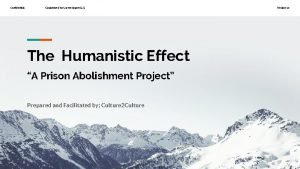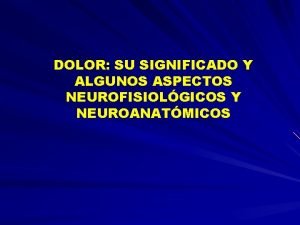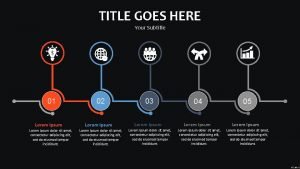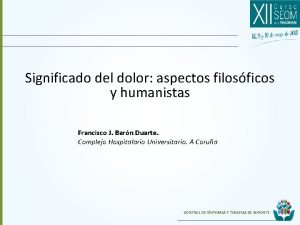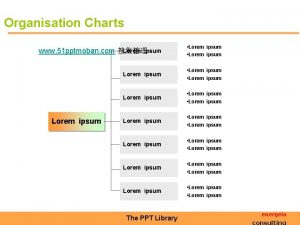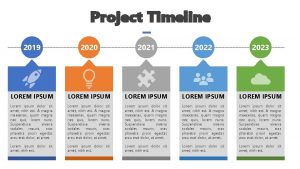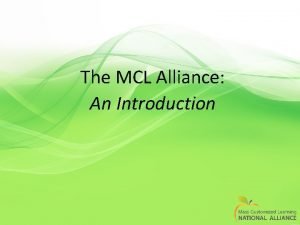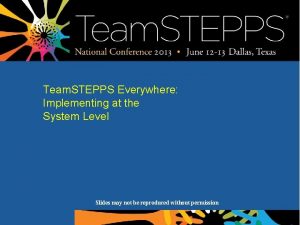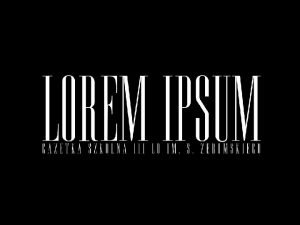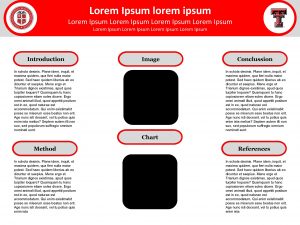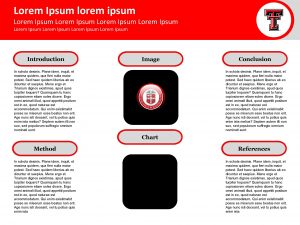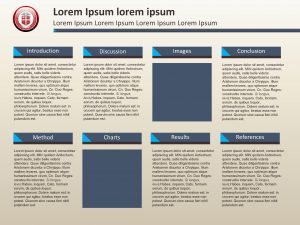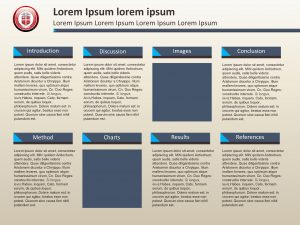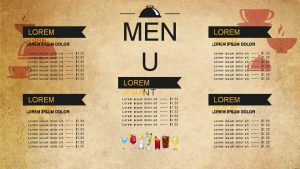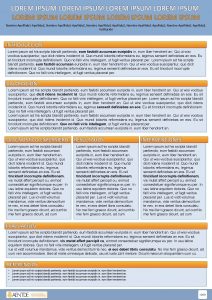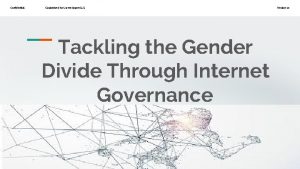Confidential Customized for Lorem Ipsum LLC The Humanistic








































- Slides: 40

Confidential Customized for Lorem Ipsum LLC The Humanistic Effect “A Prison Abolishment Project” Prepared and Facilitated by; Culture 2 Culture Version 1. 0

Introductions; ➔Eddie Perhonitch - eddie@culture 2 culture. org ➔Joseph Szeliga - joe@culture 2 culture. org ➔Vincent Murray - vinnie@culture 2 culture. org

Overview The Humanistic Effect is constructed and will continually develop in and from the combination of lived experiences from individuals who have been incarcerated as well as individuals who have worked within the judicial system. Our mission is to eliminate the current models of prison and correctional structures that are based in punishment, incapacitation, deterrence and rehabilitation with a purpose, driven by transformation involving; transformative disciplines, restorative placement, rehabilitative incentives and individualized reintegration strategies.

Objectives “Present and expand on how the Humanistic Effect works as a platform for system transformation” 1 2 Establish the urgency and necessity for abolishing our current prison systems and judicial patterns, especially for individuals with mental illness and substance use disorders. Brief overview of the Sequential Intercept Model and how it provides a framework for segmenting the system for design and structure transformation. 3 4 Define Transformative Justice by comparison to Criminal Justice; facilitated via 20 minute interactive session. Process and discuss theoretical models or concepts in abolishing prison, correctional restructuring and judicial reintroductive policies.

Understanding Prison Abolition

Prison Abolition 01 The prison abolition movement is a formal and informal network of groups and activists that seek to reduce or eliminate prisons and the prison system, and replace them with systems of rehabilitation that do not place a focus on punishment and government institutionalization.

Prison Abolition 02 The prison abolition movement is a loose network of groups and activists that seek to reduce or eliminate prisons and the prison system, and replace them with systems of rehabilitation that do not place a focus on punishment and government institutionalization.

Understanding “The Urgency”

Criminal Justice 01 Criminal justice is the delivery of justice to those who have committed crimes. The criminal justice system is a series of government agencies and institutions whose goals are to identify and catch unlawful individuals to inflict a form of punishment on them. Other goals include the rehabilitation of offenders, preventing other crimes, and moral support for victims. The primary institutions of the criminal justice system are the police, prosecution, the courts, the prisons and community corrections.

Transformative Justice 02 Transformative justice is the delivery of justice to a human being from one or body of equal human beings. Transformative justice is a collection of government agencies and service institutions whose goals are to identify, interview, inform and sanction individuals with a form of corrective discipline. Other goals include creating habilitation platforms and rehabilitation incentives for offenders, preventing other crimes with restorative placement, skill development, and mutual support for offenders and victims consisting of individualized reintegration strategies (recitizenship). Humanistic Effect

Trend Analysis The United States is the world's leader in incarceration with 2. 2 million people currently in the nation's prisons and jails — a 500% increase over the last forty years. Changes in sentencing law and policy, not changes in crime rates, explain most of this increase. These trends have resulted in prison overcrowding and fiscal burdens on states to accommodate a rapidly expanding penal system, despite increasing evidence that large-scale incarceration is not an effective means of achieving public safety.


Prison Abolition Movement Targets 01 | Eliminate 45% of Prison Population 02 | Eliminate 60% of Probation & Parole 03 | Remove 100% of Substance Use Offenders 04 | Remove 100% of Mentally ill Offenders 05 | Activate Suspended Sentencing for all nonviolent crimes

Sentencing policies of the War on Drugs era resulted in dramatic growth in incarceration for drug offenses. Since its official beginning in the 1980 s, the number of Americans incarcerated for drug offenses has skyrocketed from 40, 900 in 1980 to 452, 900 in 2017. By 2004, people convicted on federal drug offenses were expected to serve almost three times that length: 62 months in prison compared to 22 months in 1986. . At the federal level, people incarcerated on a drug conviction make up nearly half the prison population. At the state level, the number of people in prison for drug offenses has increased ninefold since 1980, although it has begun declining in recent years. Most are not high-level actors in the drug trade, and most have no prior criminal record for a violent offense.

Probation and Parole… The silent assassin to recitizenship

National Mass Incarceration and Supervision Rates of U. S. Supervision The vast majority of people under correctional control are on probation and parole, collectively known as community supervision (or community corrections). An estimated 4. 5 million adults are under community supervision, nearly twice the number of people who are incarcerated in jails and prisons combined. Yet despite the massive number of people under their control, parole and probation have not received nearly as much attention as incarceration. Only with recent high-profile cases has the public begun to recognize the injustices plaguing probation and parole systems, which set people up to fail with long supervision terms, onerous restrictions, and constant scrutiny. Touted as alternatives to incarceration, these systems often impose conditions that make it difficult for people to succeed, and therefore end up channeling people into prisons and jails.

While far from an exhaustive list, typical probation requirements include: ● Paying supervision fees, fines, restitution or other fees ordered by the court, very often without considering the individual’s ability to pay; ● Regularly reporting to a parole or probation officer; ● Finding and maintaining full-time employment or education; ● Submitting to drug and alcohol tests, which the individual is often forced to pay for (this is often a condition even if the offense was not related to drugs or alcohol); ● Abiding by strict curfews and submitting to electronic monitoring, which, again, the individual often must pay for; ● Not changing employment or residence without permission; ● Attending specific programs (such as an anger management class); ● Not leaving a designated area without permission (such as the city, county, or state); and ● Not associating with people with criminal records, including family and friends.

Alarming Probation Problem Confined and Costly “Our goal as criminal justice leaders should always be to improve public safety for our citizens by having people leave our custody less likely to commit a crime than when they came to us, ” said Pennsylvania Department of Corrections Secretary John Wetzel. “With four times as many people on probation than on parole, policymakers should take a hard look at this population in their states. By doing so, states could achieve larger reductions in crime, arrests and prison admissions and allow criminally involved individuals to be fully restored. ”

A Framework. . . Sequential Intercept Model

Sequential Intercept Model

What is the Sequential Intercept Model The Sequential Intercept Model provides a conceptual framework for communities to use when considering the interface between the criminal justice and mental health systems as they address concerns about criminalization of people with mental illness. The model envisions a series of points of intercept at which an intervention can be made to prevent individuals from entering or penetrating deeper into the criminal justice system. By; Munetz - Griffin

What is the Sequential Intercept Model The model provides an organizing tool for a discussion of diversion and linkage alternatives and for systematically addressing criminalization. Using the model, a community can develop targeted strategies that evolve over time to increase diversion of people with mental illness from the criminal justice system and to link them with community treatment. By; Munetz - Griffin





MULTIPLE INTERCEPTS: FRONT END SUBSTITUTION and DIVERSION MOST EFFECTIVE • Best intervention point is in the community, where treatment needs are met through suspended sentencing and mental health/D&A services, before law enforcement involvement. • Even with community services in place, some people slip through the cracks and encounter law enforcement. • In a system with appropriate interventions at each potential intercept, most people should be immediately diverted from justice involvement. • Individuals with mental illness and substance use disorders who are incarcerated must be connected with services immediately upon arrest, in custody and upon release to prevent further justice systemcontact. • Some people with mental health and substance use challenges need to be incarcerated or justice system involved (violent crimes) and receive a high degree of community supervision and services.

What Is Transformative Justice

The Conundrum, The Call, The Comparison, The Challenge (The Process) The Conundrum - is the current disorganized and at select stages dehumanizing state of the prison system The Call - mobilize and unite in a movement to eliminate or reduce the social impact of incarceration by creating alternatives to the prison system or eliminating it completely The Comparison - what currently exists and what alternatives meet the call The Challenge - creating alternatives and influencing the lawmakers to orchestrate laws and policies for the future

The Conundrum, The Call, The Comparison, The Challenge (The Process) Current 4 Objectives of the Prison System Punishment - “It is unquestioned that confinement in a prison. . . is a form of punishment subject to scrutiny under the Eighth Amendment standards. ’ ” 282 “ Conditions [in prison] must not involve the deliberate and unnecessary infliction of pain, nor may they be grossly disproportionate to the severity of the crime warranting imprisonment. . Conditions. . . , alone or in combination, may deprive inmates of the minimal civilized measure of life’s necessities. Incapacitation - refers to the restriction of an individual's freedoms and liberties that they would normally have in society. Within the criminal justice system, incapacitation is the response used when a person has been imprisoned for a time equal to the crime committed. By incapacitating the convicted offender, the criminal justice system prevents the individual from committing future crimes because he/she is removed from society and locked up or restrained somehow.

The Conundrum, The Call, The Comparison, The Challenge (The Process) Current 4 Objectives of the Prison System Deterrence - is that people don't commit crimes because they are afraid of getting caught instead of being motivated by some deep moral sense. According to deterrence theory, people are most likely to be dissuaded from committing a crime if the punishment is swift, certain and severe. For example, in the candy bar theft, if there is a low likelihood that you'll get caught or if the punishment for getting caught is just a warning, deterrence theory says you'll be more likely to steal it. Rehabilitation - is based on the ideas that people are not inherently bad. Instead they are taught to make wrong decisions by environmental influences. This is the classic nature versus nurture argument. Are people born bad or are they made that way due to poverty, bad parenting, economic status, education, trauma, or abuse? Studies have shown how nurturing (environmental influence) affect crime rates.

The Conundrum, The Call, The Comparison, The Challenge (The Process) Current 4 Dimensions of the Transformative Justice Transformative Disciplines - the sanctions; such as suspended sentences, alternative sentencing involving treatment, community services, vocational strategies, housing supports, faith options, educational planning, etc. Restorative Placement - crime and criminal activity has a way of repeating itself based on lifestyle and habits; restorative placement are innovative options of removing individuals from society based on not meeting sanctions associated with transformative disciplines. Examples of Restorative Placement; Geo-economic Vocational Training Centers, 90 -Day Wellness and Recovery Centers, Faith Exploratory Camps

The Conundrum, The Call, The Comparison, The Challenge (The Process) Current 4 Dimensions of the Transformative Justice Rehabilitative Incentives - the concept of incentives within restorative placements to expunging records, family involvement in placement, home passes, job placement, Individualized Reintegration Strategies (Recitizenship Planning) - criminology is a science developed by observing criminal behavior based on three levels; precrime - postcrime characteristics. Instead of creating mechanisms to “catch” and “punish” individuals associated with criminalistic lifestyles and choices we must observe, invite, challenge and release individuals based on mutually beneficial recitizenship plans of action. IRS (Individualized Reintegration Strategies) must consist of these five dimensions; 1. Individualized & Strength Based 2. Educational 3. Exposure & Influence 4. Awareness(mindfulness) & Regulation (emotional intelligence) 5. Intentional & Empowering

The 9 Perspectives of Prison Abolition Perspective 1: Imprisonment is morally reprehensible and indefensible and must be abolished. Perspective 2: The message of abolition requires "honest" language and new definitions. Perspective 3: We believe reconciliation, not punishment, is a proper response to criminal acts. Perspective 4: We work with prisoners but always remain "non-members" of the established prison system. Perspective 5: We are "allies" and “advocates” of prisoners rather than traditional "helpers. " Perspective 6: We realize that the empowerment of prisoners and ex-prisoners is crucial to prison system change. Perspective 7: We view power as available to each of us for challenging and abolishing the prison system. Perspective 8: We believe that crime is mainly a consequence of the structure of society. Perspective 9: We believe that it is only in a caring community that corporate and individual redemption can take place. www. prsionpolicy. org

Interactive Learning Session Based on today’s workshop, let’s get started in our interactive learning session! Here are 5 areas to discuss 1. 2. 3. 4. How can Peer Support help with abolishing prisons? Why should we abolish prisons? Where should we start? Which one of the 4 Dimensions of Transformative Justice makes the most sense? 5. Do prisons actually make society safer?

Vision… A 10 Year Plan Formalize a United Front Institute Pilots Initiative 2022 2020 Implement National Alternative Policies 2024 Gain Support of Lawmakers 2030 2026 2028 National Review of Initiative Quality and Innovation Planning

“Even if we were to greatly diminish the current prison population, even if we were to cut it in half but keep the prison complex intact, we would still be consigning millions of people to isolation and violence—and that’s a form of inhumanity that abolitionists can’t abide. Moreover, mass imprisonment “reproduces the very conditions that lead people to prison. ” By: Angela Davis

“How have we, a civilized society allowed the prison industrial complex to criminalize what has been long recognized and treated as severe medical conditions such as mental illness and addiction. Both conditions; require treatment and healing not punishment and further exposure to inhumane conditions that are inconsistent with an environment that compliments symptom relief and that are grossly disproportioned to the crime committed…” By: Eddie Perhonitch

Eddie Perhonitch Joseph Szeliga Vincent Murray Team Eddie Perhonitch eddie@culture 2 culture. org Joseph Szeliga joe@culture 2 culture. org Vincent Murray vinnie@culture 2 culture. org Co-Founder and Chief Culturing Officer Chief Blessings Officer and Director of Finance and Contracts Chief Posturing Officer and Director of Operations Sales Director Wendy Writer

Thank you.
 Lorem ipsum llc
Lorem ipsum llc Haz paleoespinotalámico
Haz paleoespinotalámico Lorem ipsum title
Lorem ipsum title Tagline of bru coffee
Tagline of bru coffee Lambeth walk dance
Lambeth walk dance Lorem ipsum dolor sit amet,
Lorem ipsum dolor sit amet, Lorem ipsum menu
Lorem ipsum menu Algotimia
Algotimia Lorem ipsum
Lorem ipsum Lorem ipsum technology
Lorem ipsum technology Energeia
Energeia Template
Template Lorem ipsum definition
Lorem ipsum definition Castra movere
Castra movere Lorem ipsum heading
Lorem ipsum heading Lorem ipsum
Lorem ipsum Lorem ipsum
Lorem ipsum Lorem ipsum dolor sit amet full
Lorem ipsum dolor sit amet full Yoursubtitle
Yoursubtitle Lorem ipsum
Lorem ipsum Lorem ipsum dolor sit ament
Lorem ipsum dolor sit ament Ska citat vara kursiva
Ska citat vara kursiva Table lorem ipsum
Table lorem ipsum Lorem ipsum
Lorem ipsum Lorem ipsum table
Lorem ipsum table Lorem logo
Lorem logo Hellmann's tree service
Hellmann's tree service Lorem ipsum thai
Lorem ipsum thai Lorem ipsum jelentése
Lorem ipsum jelentése Floating head with backing device
Floating head with backing device Mass customized learning
Mass customized learning Customized business solutions
Customized business solutions Tps6213
Tps6213 Ipassthebaton
Ipassthebaton Generic software and custom software
Generic software and custom software Lorem logo
Lorem logo 彭德威
彭德威 Lorem
Lorem Lorem im
Lorem im Lorem
Lorem Biologiska arvet
Biologiska arvet
